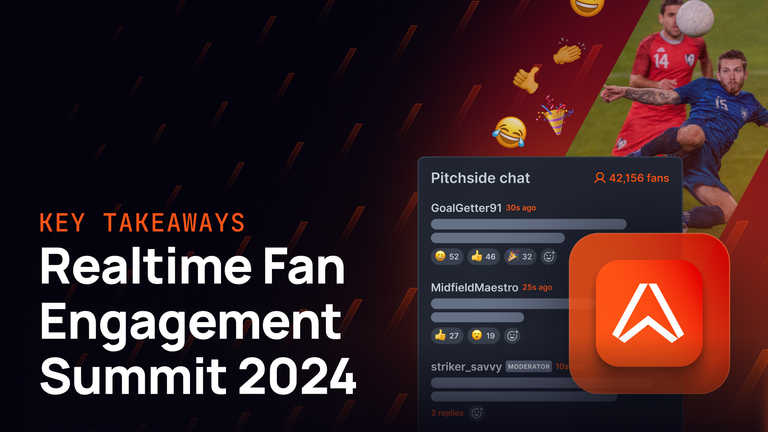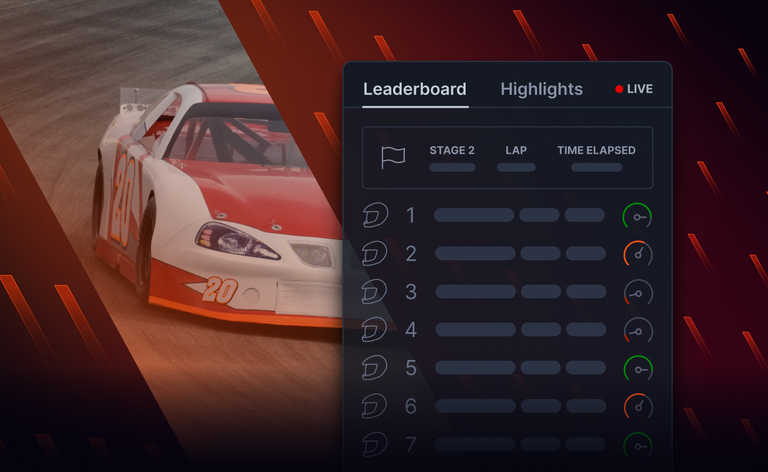At Ably's February fan engagement event, Sam Renouf, CEO of the Professional Triathletes Organisation (PTO), captured the essence of impactful fan engagement with an observation about motorsports:
If you strip away all of the data from Formula 1, you've got a two-hour show of cars going around so fast that you don't know what's going on. But if you layer in data and realtime metrics, either audio or graphical, you can actually get engaged in the race.
Sam's insight points to a transformation across sports, and fan experiences more generally: that effective engagement now depends on meaningful realtime data storytelling. The core question for companies looking to drive fan engagement becomes: how exactly do you turn fleeting moments into immersive, emotionally engaging fan experiences?
In this article, we explore how leading companies are using realtime data to transform small moments into sustained emotional engagement—and what it takes to scale these experiences across diverse fanbases.
How leading organizations are solving for realtime engagement
So what does it look like when companies deliver the right data at the right moment to create engaging fan experiences?
The PTO provides one of the clearest examples of how combining realtime data with an understanding of audience needs can elevate an entire category of sports content.
Traditionally, endurance sports were considered challenging to broadcast in an engaging way. Under Sam's leadership, the PTO introduced live athlete telemetry, heart rate monitors, split times, and positioning data to bring viewers into the unfolding drama. As he explained at the event, they had to "physically turn the athletes into a data model" to capture metrics that tell the story of a race in progress.
The PTO's approach transformed what was, in Sam's words, "like watching paint dry" into a compelling narrative. By displaying heart rate percentages during critical moments, viewers could see that one athlete was running at 85% capacity while competitors were pushing into the 90% range—creating immediate tension and drama about who might fade first.
What truly sets the success of the PTO apart is their understanding of their audience. Sam observed that the triathlon community had been underserved for years. Despite being a mass participation sport with deeply committed athletes, there was a notable lack of tailored content for fans. The PTO tapped into this pent-up demand, revealing just how hungry this audience was for engaging, data-enhanced experiences.
Sam shared the remarkable results: "We took a basket of professional rights holders and measured our engagement on social media versus theirs. And we're 5 to 10x. And that includes people like UFC."
He attributes this not just to the data alone, but to the nature of their audience: highly-invested, highly-engaged athletes who actively seek content they can relate to. For them, realtime data isn't just interesting — it’s deeply personal and validating.
But the PTO isn’t the only organization leading here either - in motorsports, NASCAR’s work is a clear example that these data-driven principles are permeating the broader sports industry—not just niche segments like endurance sports.
At the 2024 Daytona 500, NASCAR leveraged Ably’s infrastructure to stream over 370 million telemetry messages from more than 40 cars to 56,000 concurrent fans via their official app. This allowed fans to interact with detailed performance metrics in realtime, shifting their role from passive viewers to active participants in the racing experience. The result was a notable uptick in engagement, especially among younger demographics.
Other great examples include Formula 1, which uses Live Timing for realtime race analytics; DraftKings in fantasy sports, who powers their matches with live player stats; and Coachella, who uses realtime audience data to personalize onsite and remote fan experiences.
The challenges of scaling realtime experiences
However, creating engaging experiences through strategic data delivery isn't simple. The panel at Ably’s latest fan engagement event — featuring speakers from the ATP Tour, Sportradar, and Sportian — surfaced several challenges:
Balancing personalization with cost
Chris Dix, CTO at ATP Tour, noted that while fans increasingly expect personalized experiences, the costs can escalate quickly:
"As soon as you start going towards hyper-personalization, it also gets really expensive. Unless you're unlocking those revenue streams to counteract that cost, you're doing too much."
Personalization requires careful balance: delivering meaningful, customized experiences without creating an unsustainable infrastructure burden. But, as the PTO example shows, even modest investments in contextual data presentation can yield outsized returns when aligned with an audience that is already highly motivated to engage.
Creating value exchange around data
There are two sides to the data equation in sports. First, the performance data organizations deliver to fans must be genuinely valuable and contextually relevant. Second, when organizations do collect fan data (like viewing preferences or engagement patterns), they must offer tangible benefits in return (a principle also highlighted in our coverage of Carlo De Marchis's keynote).
For deeply-invested superfans in particular, value comes from receiving the specific performance metrics they care about most, delivered at moments that matter. When organizations consistently meet this expectation, they create stronger relationships with fans and establish a foundation for more personalized experiences.
Prioritizing critical moments
Not all moments in a race or match are equally significant. To avoid overwhelming fans, realtime experiences need to focus on high-impact moments: decisive overtakes, crashes, tire gambles, or a race-defining final lap.
The technical challenge here is substantial: systems must be capable of handling massive spikes in data volume and user activity during these critical moments. When thousands of fans simultaneously check their devices during a pivotal play or final lap, the infrastructure must scale instantly while maintaining low latency.
This requires sophisticated load balancing, efficient message handling, and resilient architecture that can dynamically allocate resources. Achieving this in practice typically involves autoscaling cloud infrastructure, load balancing at the edge, high-throughput messaging systems capable of fanout, and low-latency data replication across regions for a seamless experience during unexpected traffic surges. (You can read more about resilient architecture on our blog.)
Delivering data to drive effective fan engagement
The future points toward even greater personalization. For example, the panel at the Ably fan engagement event highlighted the role that AI is expected to play in driving personalized fan experiences, such as multilingual realtime commentary, or hyper-personalized match feeds.
Meanwhile, thought leaders like Sam Renouf remind us that the foundation must always be laid with strong, meaningful data storytelling. The PTO’s success in triathlon shows how even traditionally "hard to broadcast" sports can become compelling, by capturing the right data and delivering it at the right moment.
The fundamentals remain: balance complexity and cost with fan value, focus on critical moments rather than data deluge, and continuously evolve realtime experiences to meet rising expectations.
Key takeaways
In short, if you’re looking to optimize your fan engagement strategy, consider:
- Prioritizing decisive moments: Identify and focus on the handful of pivotal moments in an event where contextual data enhances the viewing experience. Use analytics to deliver insights precisely when fans are most receptive, like during break points in tennis or final laps in racing.
- Focusing on genuine value: Clearly communicate the specific benefits fans receive when they share their data—whether exclusive content, personalized insights, or premium interactive experiences. Transparency builds trust and long-term loyalty.
- Balancing personalization and cost: Innovate sustainably by using AI and automation to deliver personalized experiences without prohibitive infrastructure investments. This can involve automated content generation, multi-screen synchronization, and hybrid subscription models to deliver personalization in cost-effective ways.
We’d love your perspective. What challenges have you encountered implementing realtime fan engagement? What opportunities do you see for the future? Tag us in socials @AblyRealtime to continue the conversation.




